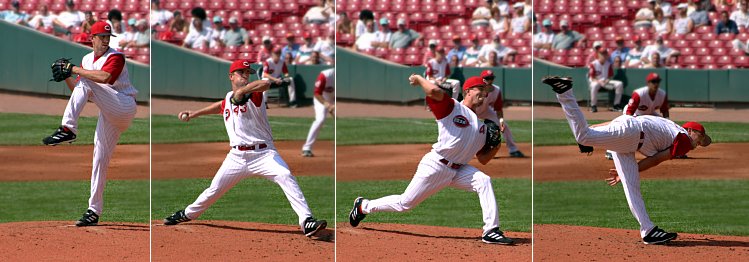We're open daily! View holiday hours
Science News
The Ability to Throw
June 26, 2013
by Molly Michelson

When you watch a pitcher wind up and throw a fastball down the middle, or a quarterback step out of the pocket and make a successful long pass, you’re seeing millions of years of human evolution and adaptations in action.
Or so say researchers Daniel Lieberman and Neil Roach. Their study, published today in Nature, determines that this uniquely human trait—high speed and high accuracy throwing—originated with our ancestors Homo erectus, two million years ago.
Darwin speculated that by freeing up the arms, bipedalism may have enabled our hominin ancestors to hunt effectively using projectiles. But scientists had been unable to pinpoint the exact time throwing became viable.
“When we started this research,” Roach says, “we asked: How do we do it? What is it about our body that enables this behavior, and can we identify those changes in the fossil record?”
The researchers began by creating a complex model that incorporated current research about the biomechanics of throwing. Using that model, they were able to explore how morphological changes to the body—wider shoulders, arms that are higher or lower on the body, the ability to twist the upper body independently of the hips and legs, and the anatomy of the humerus—affect throwing performance.
They also studied 20 experienced human throwers during overhand baseball pitching, demonstrating that several derived anatomical features that enable elastic energy storage and release at the shoulder are central to our ability to throw powerfully and accurately. (Video is available of these mechanics on Harvard’s website.)
“We try to push these bits of anatomy back in time, if you will, to see how that affects performance,” Roach says. “The important thing about our experiments is that they went beyond just being able to measure how the restriction affects someone’s ability to throw fast and accurately—they allowed us to figure out the underlying physics. For example, when a thrower’s velocity dropped by 10 percent, we could trace that change back to where it occurred.
“In order to test our evolutionary hypotheses, we needed to link the changes we’d seen in the fossil record to performance in terms of throwing,” he continues. “This type of analysis allowed us to do that.”
This throwing ability was incredibly important for our ancestors, the researchers say. It helped them become more successful hunters and carnivores, paving the way for a host of later adaptations, including increases in brain size and migration out of Africa.
However, while speed and accuracy proved a crucial development for early hunters, the study’s authors warn that repeated use of this motion can result in serious injuries in modern throwers, especially in young baseball players, who often suffer from laxity and tearing in the ligaments and tendons of their shoulders.
“I think it’s really a case of what we evolved to do being superseded by what we’re now asking athletes to do,” Roach says. “Athletes are overusing this capability that gave early humans an evolutionary advantage, and they’re overusing it to the point that injuries are common.”
Image: Rick Dikeman/Wikipedia